#Jules Henri Vernoy de Saint-Georges
Explore tagged Tumblr posts
Text
Valeriya Bespalova Валерия Беспалова

Valeriya Bespalova Валерия Беспалова as one of "The Three Odalisques”, “Le Corsaire Корсар”, choreo by Jules Perrot, Marius Petipa and Pyotr Gusev Петр Гусев, libretto by Jules Henri Vernoy de Saint Georges and Joseph Mazilier, edited by Yury Slonimsky Юрий Слонимский and Pyotr Gusev Петр Гусев, music by Adolphe Adam, Cesare Pugni, Léo Delibes, Riccardo Drigo and Pyotr Oldenburg Петр Ольденбургский, Mariinsky Ballet Мариинский театр, Saint Petersburg, Russia (October 30-31, 2024; New Stage).
Source and more info at: Photographer Aleksandr Neff on Facebook Photographer Aleksandr Neff on Instagram Photographer Aleksandr Neff on VKontakte
via Valeriya Bespalova on Instagram
Note I: This blog is open to receiving and considering any suggestions, contributions, and/or criticisms that may help correct mistakes or improve its content. Comments are available to any visitor.
Note II: Original quality of photographs might be affected by compression algorithm of the website where they are hosted.
#Adolphe Adam#Aleksandr Neff Александр Нефф#Cesare Pugni#Корсар#Joseph Mazilier#Jules Henri Vernoy de Saint-Georges#Jules Perrot#Léo Delibes#Le Corsaire#Mariinsky Ballet Мариинский театр#Marius Petipa#October 30 2024#October 31 2024#Odalisques#Pyotr Gusev Петр Гусев#Pyotr Oldenburgsky Петр Ольденбургский#Riccardo Drigo#Russian Ballet#Valeriya Bespalova Валерия Беспалова#Yury Slonimsky Юрий Слонимский
2 notes
·
View notes
Text

Maria Khoreva as Giselle, ballet "Giselle", choreography by Jean Coralli, Jules Perrot and Marius Petipa, music by Adolphe Adam, libretto by Jules Henri Vernoy de Saint Georges, Théophile Gautier and Jean Coralli, set design by Igor Ivanov, costume design by Irina Press, Mariinsky Ballet, Saint Petersburg, Russia.
Photographer Aleksandr Neff
51 notes
·
View notes
Text
Photos from my Opera Garnier Trip 2 of 3
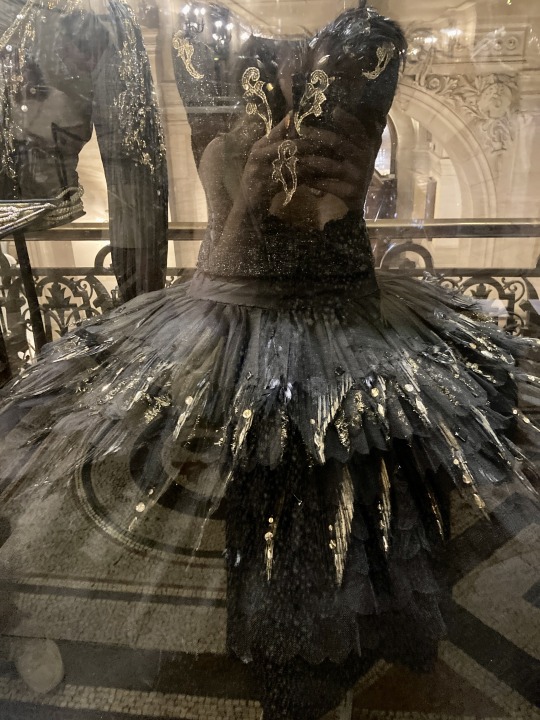
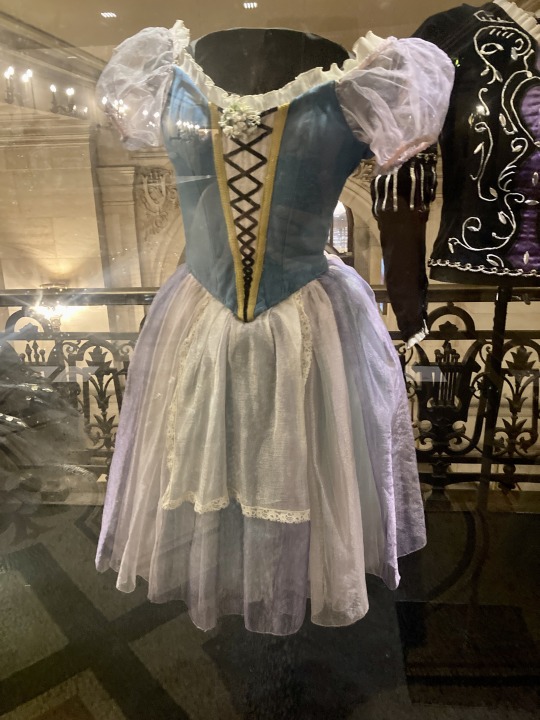

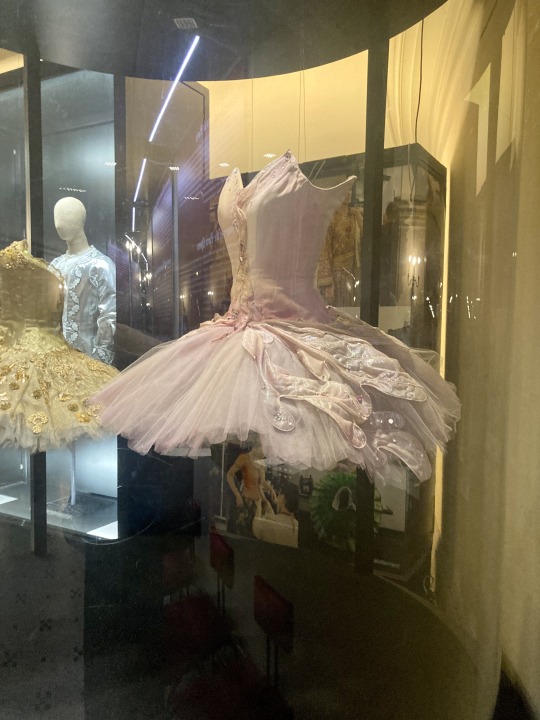
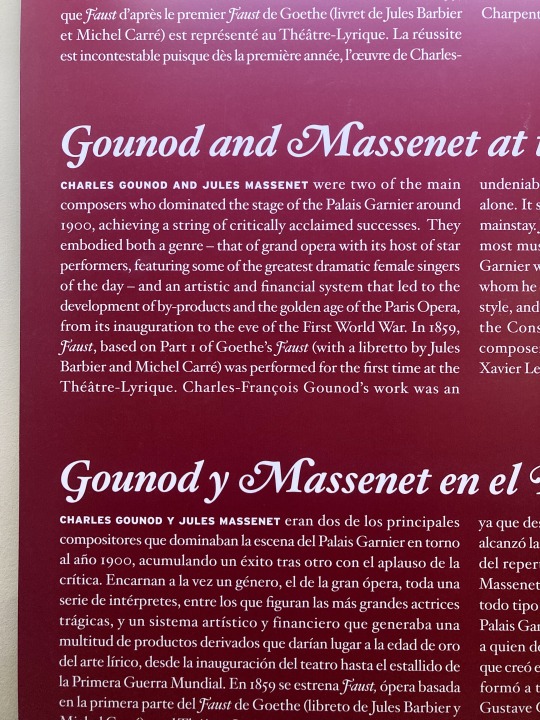
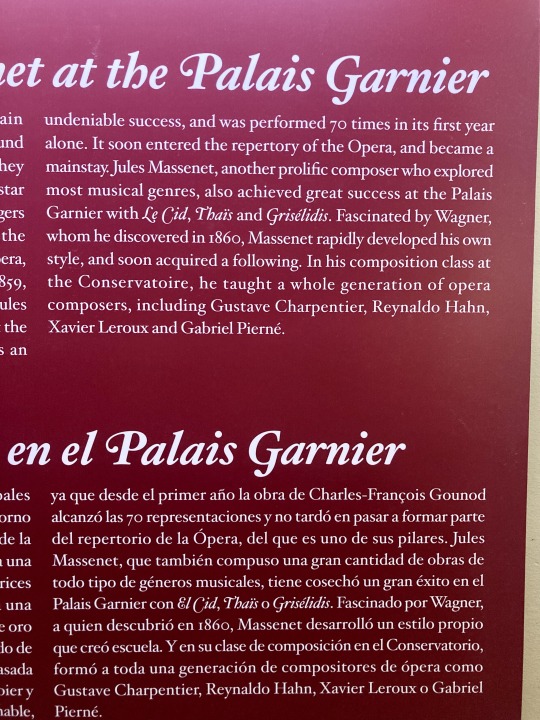


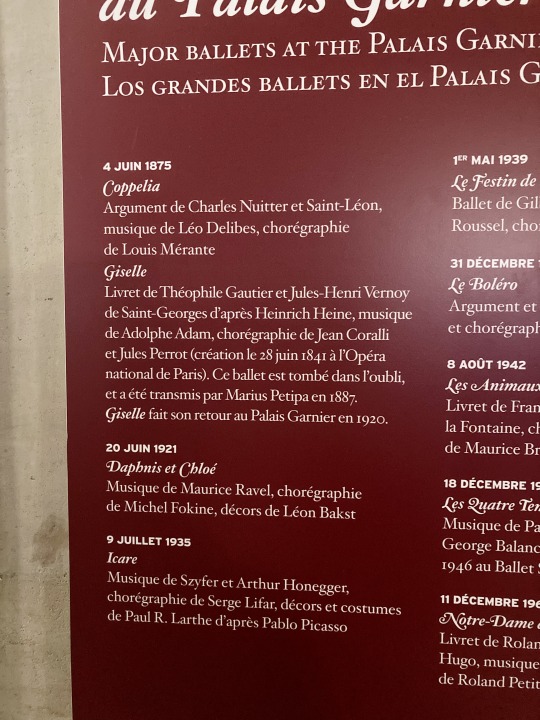


Took some photos of the exhibit up at the Opera Garnier for my own (cough cough) research purposes and thought it might be helpful for others! Thought the Don Quixote dress looked awfully familiar!
Transcript of the information under the cut:
Gounod and Massenet at the Palais Garnier
Charles Gounod and Jules Massenet were two of the main composers who dominated the stage of the Palais Garnier around 1900, achieving a string of critically acclaimed successes. They embodied both a genre - that of grand opera with its hoses of star performers, featuring some of the greatest dramatic female singers of the day - and an artistic and financial system that led to the development of by-products and the golden age of the Paris Opera from its inauguration to the eve of the First World War. In 1859, Faust, based on Part 1 of Goethe's Faust (with a libretto by Jules Barbier and Michel Carre) was performed for the first time at the Theater-Lyrique. Charles-Francois Gounod's work was an undeniable success and was performed 70 times in its first year alone. It soon entered the repertory of the Opera and became a mainstay. Jules Massenet, another prolific composer who explored most musical genres, also achieved great success at the Palais Garnier with Le Cid, Thais, and Griselidis. Fascinated by Wagner, whom he discovered in 1860, Massenet rapidly developed his own style, and soon acquired a following. In his composition class at the Conservatoire, he taught a whole generation of opera composers, including Gustave Charpentier, Reynaldo Hahn, Xavier Leroux, and Gabriel Pierne.
Opera at the Palais Garnier around 1900
While Jules Massenet, Charles Gounod, and Giuseppe Verdi (who supervised the first performances of his words at the Palais Garnier himself) were all triumphantly acclaimed at the Paris Opera in their lifetimes, Wagner took a little longer to inspire the unanimous recognition of the Parisian public. His rise was slow but the deeply-rooted and Germany's most famous composer finally enjoyed genuine success thanks to the unremitting work of a management team headed by Andre Charles Prosper Messager (1908-1914) known as "Messager", and Leimistin Broussan, known as "Broussan". As a result, Paris audiences were able to see a performance of the entire Ring cycle for the first time in June 1911. At this period, the Palais Garnier hosted Serge Diaghilev's Ballet Russes company, and Richard Strauss' Salome and Saint-Saens Dejanire both entered the repertory. During the Belle Epoque, the Palais Garnier was one of the chief places for Paris society to meet and be entertained, with an audience of subscribers made up of leading financiers, industrialists, and politicians.
Major Ballets at the Palais Garnier
4 June 1875
Coppelia - Argument de Charles Nuitter et Saint-Leon, Musique de Leo Delibes, choregraphie de Louis Merante
Giselle - Livret de Theophile Gautier et Jules-Henry Vernoy de Saint-Georges d'apres Heinrich Heine, musique de Adolphe Adam, choregraphie de Jean Coralli et Jules Perrot (creation le 28 Juin 1841 a l'opera national de Paris). Ce ballet est tombe dans l'oubli, et a ete transmis par Marius Petipa en 1887. Giselle fait son retour au Palais Garnier en 1920
20 Juin 1921
Daphnis et Chloe
musique de Maurice Ravel, choregraphie de Michel Fokine, decors de Leon Bakst
9 Jullet 1935
Icare
Musique de Szyfer et Arthur Honegger, choregraphie de Serge Lifar, decors et costumes de Paul R Larthe d'apres Pablo Picasso
18 notes
·
View notes
Text
14-19/05/24 - "Giselle" - Balletto - musica di A.-C. Adam - Stag. Lirica e di Balletto - A.Desimpelaere, dir.- Teatro Lirico "G.Verdi" - Trieste
Vi informiamo che dal 14 al 19/05/24, presso Teatro Lirico “G.Verdi” – Trieste, vi sarà l’esecuzione del balletto “Giselle” – Balletto – musica di A.-C. Adam. dettagli GISELLE Musica di Adolphe-Charles Adam Balletto in due atti di Jules-Henry Vernoy de Saint-Georges da Théophile Gautier Prima rappresentazione: Parigi, Opera National de Paris, 28 giugno 1841 CoreografieJOSÉ CARLOS…

View On WordPress
0 notes
Text
A Cia. Paulista de Dança encena sua versão para Giselle, considerado um dos balés clássicos de repertório mais famosos do mundo. O espetáculo, dirigido por Adriana Assaf, tem apresentações no Teatro Sérgio Cardoso entre 17 e 26 de novembro, às sextas, às 20h30, aos sábados, às 16h e às 20h30, e aos domingos, às 16h. Encenado originalmente em 1840 pela Ópera Nacional de Paris, com coreografia de Jules Perrot e Jean Coralli, o balé romântico foi composto em dois atos por Adolphe Adam sobre um libreto de Jules-Henri Vernoy de Saint-Georges e Théophile Gautier. Trata-se de uma história de amor, traição, perdão e redenção. O espetáculo da Cia. Paulista de Dança é estrelado pelos primeiros-bailarinos Larissa Luna (Giselle), Livia Cassante (Mirtha), Paulo Vitor Rodrigues (Albretch) e Marcos Silva (Hilarion). A história se passa em uma pequena vila na Europa, onde Gisele, uma camponesa apaixonada pela dança, vive com sua mãe viúva. A jovem apaixona-se por Albrecht, que finge ser camponês para conquistar seu coração. Eles planejam se casar, no entanto, Giselle descobre o amado é, na verdade, um nobre prometido em casamento a outra mulher, chamada Bathilde. Devastada com a traição, a protagonista enlouquece e morre de tristeza e decepção. No segundo ato, a jovem desiludida retorna ao mundo como uma Willis, o espírito de uma noiva abandonada que dança na madrugada em busca de vingança contra os homens que a enganaram. Myrtha, a rainhas das Willis, ordena que Giselle dance com seu ex-noivo até a morte. Entretanto, Giselle ainda ama Albrecht e perdoa-o. Para salvá-lo, ela convoca a ajuda dos espíritos da natureza e lhe concede o perdão final. Giselle, então, retorna à sepultura e Albrecht lamenta a perda de seu amor. Escrita em pleno século XIX, a emocionante história de Giselle combina o amor romântico, a tragédia, o sobrenatural e a redenção. A obra-prima do romantismo foi um sucesso imediato em 1840 e, desde então, tem sido montada por companhias de todo mundo em forma de ópera, musical e até filmes. Sinopse Um dos balés românticos mais famosos do mundo, Giselle narra o drama de uma jovem camponesa que ama dançar e apaixona-se perdidamente por um nobre que esconde para ela o fato de já estar prometido a outra mulher. Quando descobre a traição, ela morre de desgosto e retorna sob a forma de Willis, o espírito de uma noiva abandonada que dança na madrugada em busca de vingança contra os homens que a enganaram. Ficha técnica Direção Artística: Adriana Assaf Direção Executiva / Produção: Robson Luna Primeiros Bailarinos: Larissa Luna, Paulo Vitor Rodrigues e Marcos Silva Solistas: Giovanna Gomes, Murillo Miron, Livia Cassante, Isis Antonelli, Jonas Moraes, Hellen Santos Corpo de Baile: Cia Paulista de Dança Contras Regras: Luis Carlos Massaro, Luciano Mussa Iluminação: Vinicius ( VS Iluminação) Fotos: Renan Livi Figurinos: Albertini, Zize Pereira, Marcia Massonato Cenografia: Carlos Alberto Belarmino, Adilson Vieira Filmagem: Reflex Video, VOX TV Realização: APDAA - Associação Paulista de Dança Personagens: Giselle- Larissa Luna e Giovanna Gomes Albrecht - Paulo Vitor Rodrigues e Marcos Silva Hilarion- Marcos Silva e Murillo Miron Myrtha - Livia Cassante e Ísis Antonelli Paysant - Murillo Miron, Jonas Moraes e João Victor Maciel, Giovanna Gomes, Helen Fernandes e Bianca Berloffa Paysant casais- Luiza Toledo e Igor Tavares, Eduarda Ferreira e Matheus Pino Bertha - Luciana Basso Wilfrid – Geasi Rodrigues e Felipe Camarotto Rei- Italo Rodrigues / Giasi Rodrigues Bathilde- Amanda Gonzaga Zulma e Moyna - Glenda Franco, Amanda Freitas, Giovanna Gomes, Laís Mello Serviço Giselle, com Cia. Paulista de Dança Apresentações: 17 a 26 de novembro, às sextas-feiras, às 20h30; aos sábados, às 16h e às 20h30; e aos domingos, às 16h. Teatro Sérgio Cardoso – Rua Rui Barbosa, 153, Bela Vista Ingressos: R$50 (inteira) e R$25 (meia-entrada) Venda online em https://bileto.sympla.com.br/event/88022/ Bilheteria: de terça a sábado, das 14h às 19h, e vendas para o espetáculo do dia, das 14h até o início do espetáculo.
Duração: 105 minutos Classificação: 10 anos Acessibilidade: teatro acessível a cadeirantes e pessoas com mobilidade reduzida.
0 notes
Video
youtube
La Fille du Régiment: “Il faut partir” South Africa soprano Pretty Yende Gaetano Donizetti with book by Jules-Henri Vernoy de Saint-Georges & Jean-François Bayard
0 notes
Text

Alina Cojocaru in Le Corsaire
#alina cojocaru#ballet#ballerina#ballet gif#my gif#principal#prima ballerina#le corsaire#lord byron#Jules-Henri Vernoy de Saint-Georges#adolphe adam
13 notes
·
View notes
Photo










A celebration of Flórez in GIFs, pt. 4: Tonio in La fille du régiment
#Juan Diego Flórez#La fille du régiment#Tonio#tenors#opera performers#behold the performance that made me fall head over heels for this guy#Gaetano Donizetti#Jules-Henri Vernoy de Saint-Georges#Jean-François Bayard#opera#opera tag#opera gifs#in honor of tonight's stream#had this is my drafts for a while figured tonight was a good time to post
31 notes
·
View notes
Text
youtube
[Belladova-Opéra Garnier's ballerina(Giselle) and soprano(Richard Coeur-de-Lion)(Kopit's Phantom(90, 91)]
0:01 15th Century Chartres(French) hymn tune ( -> Saw You Never, in the Twilight(Cecil Frances Alexander)(1853)) - Michèle Lagrange
0:13 Giselle(, ou les Wilis (=Giselle, or The Wilis') 2:35 )(1841)(Music - Adolphe Charles Adam) (* Teri Polo who played Belladova(and Christine) had learned ballet for many years.)
1:25 Giselle(, ou les Wilis)(1841)
(Choreographer - Jean Coralli & Jules Perrot, Music - Adolphe Charles Adam, Libretto - Jules-Henri Vernoy de Saint-Georges & Théophile Gautier)
-----------------------------------------------
- Yvette Chauviré(Giselle) & Cyril Atanasoff(Albrecht)
(* Yvette Chauviré was a French 'Prima ballerina assoluta'(She is the only French dancer to hold the title) and actress. She is often described as France's greatest ballerina, and was the coach of prima ballerinas Sylvie Guillem and Marie-Claude Pietragalla. The role of Giselle was a particular passion for Chauviré, and she considered it her signature piece. Of course, she is considered one of the gratest Giselles in history.)
1:56 Carla Fracci(Giselle) & Erik Bruhn(Albrecht)
(* Carla Fracci was an Italian ballet dancer, actress and ballet director. Considered one of the greatest ballerinas of the 20th century, she was a leading dancer of La Scala Theatre Ballet in Milan, then worked freelance with international companies including the Royal Ballet, London, Stuttgart Ballet, Royal Swedish Ballet and American Ballet Theatre. Fracci is known for her interpretation of leading characters in several Romantic ballets, such as La Sylphide, Giselle, Swan Lake, and Romeo and Juliet. Fracci is considered one of the gratest Giselles in history too.)
--------------------------------------------------
5:34 & 6:20 Je crains de lui parler la nuit(= I'm afraid to talk to him at night)(André Grétry's Richard Coeur-de-Lion(=Richard the Lionheart)(1784)) - Michèle Lagrange
(* André Grétry(you might see his face at Belgium 1000 Francs) was a composer from the Prince-Bishopric of Liège (present-day Belgium), who worked from 1767 onwards in France and took French nationality. He is most famous for his opéras comiques.)
7:42 Je crains de lui parler la nuit
(André Grétry's Richard Richard Coeur-de-Lion(1784)) - Mady Mesplé
11:03 / 13:45 Пётр Ильи́ч Чайко́вский(Pyotr Ilyich Tchaikovsky)'s Пиковая дама(= Pique Dame = The Queen of Spades)(1890). Tchaikovsky(Чайко́вский)used Grétry's 'Je crains de lui parler la nuit'.(In Grétry's Opera, Soprano sings this, but in Tchaikovsky(Чайко́вский)'s opera, Mezzo Soprano sings this song.)
13:45 - Soňa Červená
15:31 - Sofia Preobragenskaya(acted by Yelena Polevitskaya)
(* Virginia Zeani - One of the greatest female opera singers of the 20th century - sang this song too(as a Countess in The Queen of the Spades(In Italian)). You can find that audio recording at youtube.)
17:29 Musical version (Kopit(Book) & Yeston(Music and lyrics)'s musical "Phantom"(1991))
P.S. You can see two famous actors - Burt Lancaster(7:39) and Олег Александрович Стриженов(Oleg Aleksandrovich Strizhenov)(14:54) in this video. From this film(Пиковая дама(1960)), Oleg Strizhenov received the Aleksandr Pushkin's Big Gold Medal and the prize of the Russian Musical Fund of Irina Arkhipova "for the brilliant realization of the figure of Hermann in the film Queen of Spades".
---------------------------------------
Playlist - Opera x The Phantom of the Opera(with English subtitles / 한글, 한국어 자막): https://youtube.com/playlist?list=PLxVjmfb0YlsGxobwIudGb5OJmVvDY7PSo
Playlist - The Phantom of the Opera 1990 × Opera(+English subtitles, 한글 자막): https://youtube.com/playlist?list=PLxVjmfb0YlsExPULC9h1BvlZfYX6sPzjs
Thank you for allowing me to use your 4k Phantom of the Opera 1990 video, Phantom Retrospective 2.0! https://youtu.be/8f3Hr422BPk
#the phantom of the opera#the phantom of the opera 1990#belladova#giselle#Richard Coeur-de-Lion#Pique Dame#The Queen of Spades#André Grétry#Tchaikovsky#Youtube
11 notes
·
View notes
Text
Gisele 🌑🩰
Por muitos anos Gisele foi o meu ballet favorito, uma obra pela qual tenho um enorme carinho e do qual guardo excelentes lembranças de uma feliz época da minha vida. Na parede do meu quarto existe um quadro que faz referência ao vestido de Gisele e as suas sapatilhas gastas. Não posso dizer que deixei de gostar da obra, apenas mudei e hoje a vejo de outra maneira, sua essência hoje apenas faz parte de alguém que um dia fui mas a pouco deixei de ser.
O principal repertório do período romântico da música, Gisele reflete a essência do romantismo: a pureza, a delicadeza, a dor, a tragédia e a redenção pelo amor. De grande importância para a história da música, seu figurino ajudou a conceber a imagem da bailarina como conhecemos hoje, um vestido de tule, sapatilhas de ponta e olhar frágil que parece buscar proteção. Gisele foi o primeiro ballet a ser dançado nas pontas por todo o corpo de baile, deixou uma marca tão profunda na história da música clássica que não há como pensar em uma valsa romântica sem vir em mente a sua suave melodia, tão doce e delicada que quase se confunde com o aroma das rosas levado pelo vento.
Composto por Adolphe Adam inspirado no livro de Jules-Henri Vernoy de Saint-Georges e Théophile Gautier, foi inicialmente interpretado pela Ópera Nacional de Paris em 1840. Quase 200 anos depois, até hoje encanta, toca a alma e, no fim das contas, nos leva a refletir sobre o que de fato é o amor e o que ele é capaz de fazer conosco.
A obra conta a história de Gisele, uma doce camponesa que ama dançar e sonha com um verdadeiro amor. Um belo dia, conhece um belo príncipe encantado e vive o sentimento da maneira mais pura e sublime possível. Em meio a sua descoberta do amor, Gisele descobre que seu belo príncipe é comprometido com outra, com quem irá se casar. Tomada pela tristeza e pela dor da sua decepção, Gisele não resiste e, literalmente, morre de amor.
Em um segundo ato, descobre-se que Gisele na verdade tornou-se uma Willis. As Willis são espíritos de mulheres que também morreram de amor que emergem sempre entre meia-noite e a alvorada para se vingar, capturando qualquer homem que entre em seus domínios, forçando-o a dançar até a morte.
Cheio de culpa pela morte da sua amada, o príncipe que a princípio apenas planejava se divertir, apaixonou-se verdadeiramente pela inocência, pureza e pelo carinho de Gisele, assim, sofreu como ninguém pela infeliz tragédia.
Em uma noite qualquer, o príncipe decide visitar o túmulo da sua amada, contudo, é surpreendido pelo aparecimento das Willis que decidem vingar-se, entretanto, a essência da Gisele é a bondade e, no fim das contas, o que ela sentia por ele, mesmo na morte, era amor, e ela seria incapaz de machuca-lo. O espírito de Gisele então retorna do túmulo e salva o príncipe perdoando-o, dessa maneira, despede-se dele e, no fim das contas, encontra a paz.
Ahhhhh… Quantas mulheres nunca foram um pouco Gisele? Eu costumava ser como ela, uma menina do interior, sonhadora, desejava casar cedo, formar uma família e viver feliz para sempre com aquele que um dia chamaria de “meu príncipe encantado”. Semelhante à Gisele, também me apaixonei perdidamente por alguém que me magoou de tal forma que, como ela, achei que fosse morrer.
Lembro como sofri, o coração sangrava, o corpo inteiro doía, faltavam palavras para explicar o que era aquilo, um sentimento de perda tão grande, como se um pedaço de mim houvesse sido arrancado, um pedaço imenso do meu peito. Não sei se era amor, ainda sou muito jovem para dizer, mas no fim das contas, eu sobrevivi, contudo, aquela decepção fez uma parte de mim morrer.
Hoje vejo as Willis como aquele sentimento que nos faz fechar o coração, evitar relacionamentos e deixar de acreditar no amor. Comigo não foi diferente, doeu tanto que achei que nunca mais seria capaz de gostar de alguém, tinha medo de viver tudo aquilo de novo e preferi ficar sozinha. Um belo dia parou de doer, o coração foi se refazendo e encontrei a redenção no instante em que perdoei verdadeiramente e encontrei a paz.
A parte de mim que morreu com a decepção não foi a vontade de amar e sim a certeza de que preciso de alguém para ter vontade de viver. Ainda acredito no amor, essa parte de mim nunca irá morrer.
No fim das contas, hoje entendo que Gisele fala sobre as decepções que vem para nos tirar de um mundo de fantasia para nos mostrar como devemos amar em um mundo real. Amar é perdoar, é fazer o bem, entregar nosso melhor e, algumas vezes, colocar a felicidade do outro antes da nossa. Amar é correr um enorme risco de se decepcionar, contudo, saber que mesmo doendo, iremos sobreviver, nos faz perder o medo.
Talvez seja uma romântica incurável mas hoje sei, depois de um tempo com o coração fechado, que posso voltar a amar, que posso voltar a sentir algo por alguém. As Willis sempre estarão ali, pessimistas, dizendo que é tudo uma ilusão, mas a essência levantará do túmulo para nos fazer sorrir mais uma vez, para sonhar com um amor tranquilo e, enquanto ele não chegar, permanecer em paz.
Parla de Paula Lima

14 notes
·
View notes
Photo

Ballets of Marius Petipa: La Fille du Pharaon
Svetlana Zakharova as Aspicia for the Bolshoi’s production
La Fille du Pharaon is the story of an Englishman exploring Egypt and falls asleep in a pyramid while taking shelter from a storm. The princess entombed in the pyramid is Aspicia and during a drug induced dream, she comes to life and turns the Englishman into an Egyptian named Taor. Obviously they fall in love, but Aspicia is promised to the King of Nubia; Aspicia and Taor run away to be married. After running away, the Pharaoh finds them and Aspicia throws herself into the river rather than marry the Nubian king. In his despair, the Pharaoh arrests Taor and sentences him to death. Meanwhile, the God of the Nile has returned Aspicia to land and she returns to the palace just in time to beg for Taor’s life. As usual in ballets, Aspicia threatens to die with Taor instead of marrying the King of Nubia, so the Pharaoh gives in and allow Taor and Aspicia to marry. However, before their marriage can take place, Taor wakes up back as the Englishman.
Set to the music of Cesare Pugni, Marius Petipa worked with the playwright Jules-Henri Vernoy de Saint-Georges on the libretto and choreographed the ballet himself. It premiered at the Imperial Bolshoi Kemenny Theatre (precursor to the Mariinsky Theatre) in Saint Petersburg in 1862. Petipa was actually the original Taor and it was his last role as a dancer before he became the ballet master. In 1898 he reconstructed his original version for the ballerina Mathilde Kschessinska and that is the production the current production is based on.
The ballet wasn’t performed during the Soviet era and wasn’t revived until Pierre LaCotte’s reconstruction in 2000 at the Bolshoi Theatre. He used all the notations available, which were only for the principal roles, but had to create the choreography for the corps/small soloists. Currently, the Bolshoi is the only company who performs any version of this ballet.
#la fille du pharaon#marius petipa#ballets of marius petipa#svetlana zakharova#bolshoi ballet#svetlana gif#prima ballerina#ballerina#ballet#dance#dancer#gif#my gif#favorite ballerina#ballet gif
22 notes
·
View notes
Text
Valeriya Bespalova Валерия Беспалова
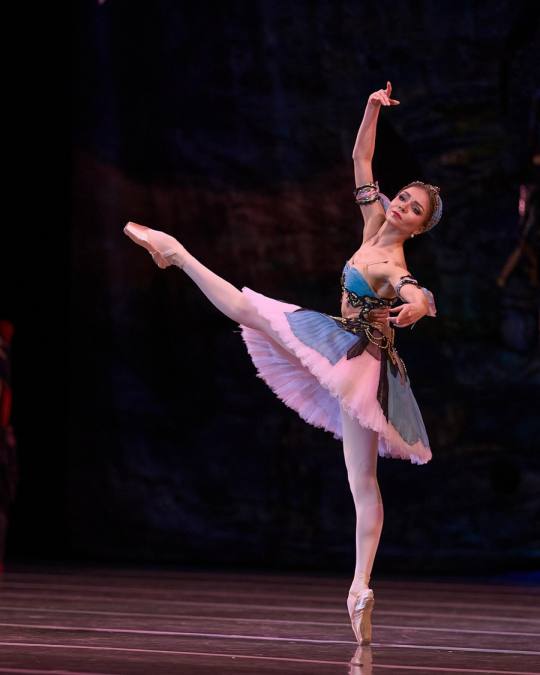
Valeriya Bespalova Валерия Беспалова as one of "The Three Odalisques”, “Le Corsaire Корсар”, choreo by Jules Perrot, Marius Petipa and Pyotr Gusev Петр Гусев, libretto by Jules Henri Vernoy de Saint Georges and Joseph Mazilier, edited by Yury Slonimsky Юрий Слонимский and Pyotr Gusev Петр Гусев, music by Adolphe Adam, Cesare Pugni, Léo Delibes, Riccardo Drigo and Pyotr Oldenburg Петр Ольденбургский, Mariinsky Ballet Мариинский театр, Saint Petersburg, Russia (October 30-31, 2024; New Stage).
Source and more info at: Photographer Aleksandr Neff on Facebook Photographer Aleksandr Neff on Instagram Photographer Aleksandr Neff on VKontakte
via Valeriya Bespalova on Instagram
#Adolphe Adam#Aleksandr Neff Александр Нефф#Cesare Pugni#Корсар#Joseph Mazilier#Jules Henri Vernoy de Saint-Georges#Jules Perrot#Léo Delibes#Le Corsaire#Mariinsky Ballet Мариинский театр#Marius Petipa#October 30 2024#October 31 2024#Odalisques#Pyotr Gusev Петр Гусев#Pyotr Oldenburgsky Петр Ольденбургский#Riccardo Drigo#Russian Ballet#Valeriya Bespalova Валерия Беспалова#Yury Slonimsky Юрий Слонимский
2 notes
·
View notes
Text

Maria Eroshenko, "Giselle", libretto by Jules Henri Vernoy de Saint Georges and Théophile Gautier, music by Adolphe Adam, Friedrich Burgmüller, Riccardo Drigo and Ludwig Minkus, choreography by Konstantin Uralsky after Jean Coralli, Jules Perrot and Marius Petipa, Astrakhan State Opera and Ballet, Astrakhan, Astrakhan Oblast, Russia
Photographer Aleksandr Potapov
34 notes
·
View notes
Text
Romantic Ballet
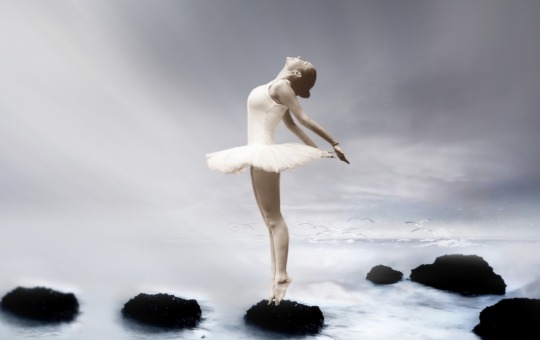
Romantic ballet dates back to the time when the ideas of Romanticism influenced art and literature. This period is set from the beginning to the middle of the 19th century mainly at the Paris Opera and the “Her Majesty's Theater” in London. Ballet romance is thought to have begun in 1827 in Paris, when ballerina Marie Taglioni danced in the ballet "The Sylphida" and reached zenith with the premiere of Pas de Quatre created by ballet master Jules Perrot in London in 1845. The end of romance in ballet came gradually. Arthur Saint-Léon's Coppélia Ballet of 1870 is considered the last romantic ballet.
One of the most famous romantic ballet performances is Giselle (or les Wilis). Giselle is a two-act ballet with libretto composed by Jules-Henri Vernoy de Saint-Georges and Théophile Gautier. The music of the ballet has been composed by Adolphe Adam while the choreography has been created by Jean Coralli and Jules Perrot. The ballet is inspired by a poem by Heinrich Heine.
Giselle was first presented by the Ballet du Théâtre de l'Académie Royale de Musique at the Salle Le Peletier in Paris, France, on June 28, 1841. The choreography of contemporary producers generally comes from Marius Petipa's revivals of the Imperial Russian (Imperial Russian Ballet).
Nowadays, classical ballet continues to exist but audience has the opportunity to watch excellent performances of modern ballet, an art that retains the technical elements of the romantic but is enriched with modern elements in movement and of course in music.
1 note
·
View note
Text
Opera Carolina Takes Aim at the Funny Bone With Donizetti’s Daughter of the Regiment
Opera Carolina Takes Aim at the Funny Bone With Donizetti’s Daughter of the Regiment
Review: The Daughter of the Regiment By Perry Tannenbaum
Late in his prolific career, including nearly 30 operas composed between 1822 and 1830, Gaetano Donizetti did something he had never attempted before. After briefly becoming the pride of Naples – until the King censored his Poliutoin 1838 – Donizetti moved to Paris, premiered his banned opera in a translated revision, and set out to write…
View On WordPress
#A.T. Jones#Alain Gauthier#Brian Perchaluk#Carl DuPont#Charlotte Symphony Orchestra#David Walton#Diane Schoff#Gaetano Donizetti#Jean-François Bayard#Jules-Henry Vernoy de Saint-George#Maariana Vikse#Matthew Burns#Sarah Coburn#Stephano Romani
0 notes
Link
CIVITANOVA MARCHE – Grande appuntamento domani 6 febbraio al cinema Rossini con la diretta via satellite dall’Opéra de Paris. Alle 19.15 va in scena Giselle, uno dei grandi balletti classici, su musica di Adolphe Adam e libretto di Théophile Gautier e Jules‑Henri Vernoy de Saint‑Georges, proposto dal corpo di ballo del prestigioso teatro francese nella coreografia di Jean Coralli e Jules Perrot, e la direzione musicale di Koen Kessels.
Il balletto è presentato da Aurélie Dupont, direttrice della danza dell’Opera Nazionale di Parigi. Biglietto unico ridotto a 10 euro.
Dal giorno seguente, 7 febbraio, prosegue la programmazione di Odio l’estate, diretto da Massimo Venier, con Aldo, Giovanni e Giacomo. Orario: venerdì 20.30-22.30; sabato 18.30-20.30-22.30; domenica 16.30-18.30-20.30.
Al Cecchetti, invece, da domani c’è Villetta con ospiti, film diretto da Ivano De Matteo, con Marco Giallini, Michela Cescon, Massimiliano Gallo, Erika Blanc, Cristina Flutur, Bebo Storti, Vinicio Marchioni, Monica Billiani, Tiberiu Dobrica. Si svolge tutto in 24 ore, in un paesino del nord Italia, dove nulla sembra turbato la tranquillità: i sette protagonisti, in realtà, si macchieranno dei sette peccati capitali, incarnandoli a perfezione e cadendo quasi innocentemente in un vortice di perdizione e violenza. Orario: giovedì 21.15; venerdì e sabato 20.30-22.30; domenica 16.30-18.30.
Nella giornate di sabato alle 18.30 e domenica alle 20.30 la pellicola si alterna con 1917, di Sam Mendes, sull’anno cruciale per la prima Guerra Mondiale.
Il prezzo di ingresso di Odio l’estate, Villetta con ospiti e 1917 è 5 €, ridotto 4 (fino a 18 anni, oltre i 65 e studenti universitari fino a 24 anni).
Per informazioni è attivo il numero TDiC informa: 351/5715757, dalle 11 alle 23, tutti i giorni ci sarà sempre un operatore a disposizione.
0 notes